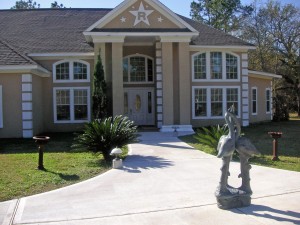When it comes to a new home, Green isi’nt just the right thing to do, it is the Smart thing to do. Both for the people who build the homes and those who live in them! It means focusing on creating a healthy indoor environment inside buildings. It makes sense to focus on improving the mass-produced materials that predominate in modern construction. It’s also about eschewing mass-produced components and centralized systems altogether in favor of site-harvested resources, including building materials, electricity, water, and food. ‘Green Building’ centers on the concept of ‘sustainability: the simple notion that the way of life we choose must not lead to circumstances that prevent that way of life from continuing. In order to create a building to serve that end, some basic traits need to be considered:
Thank you for reading this post, don't forget to leave a comment.
Low Construction Impact Building,
almost by definition, is initially a destructive act. Land usually has to be at least minimally cleared and reshaped, holes need to be dug, and material resources refashioned to serve the building. A ‘green’ building minimizes its impact on the building site and the environment at large through careful, conscious design and by utilizing replenishable materials that create a minimum of ecological destruction through their use.
Resource-Efficient
The impact of a building’s construction is only part of the story. Once a building is built, people move in and use it. This human use requires environmental resources for such things as heating, cooling, water, and electricity. A ‘green’ building provides these human needs efficiently, conserving resources.
Long-Lasting
Natural resources in the form of building materials, tools, and fuels, as well as human energy and ingenuity, come together to create a building. The longer that building lasts, the longer the time before the environment is asked to give up those resources again to replace the building. Therefore, the longer a building lasts, the ‘greener’ it is.
Nontoxic
To sustain healthy lives, we need to sustain a healthy indoor and outdoor environment. A ‘green’ building, then, needs to provide a healthy indoor environment while doing nothing to harm the outdoor environment.
Beautiful
One of the biggest sources of our environmental woes is the constant and polluting movement of humans about the planet. To create a sustainable lifestyle, we need to stay put more of the time and derive more of our social, physical, and spiritual sustenance from our own backyards. For example, it takes a long time to build healthy soil to grow good food; to build a network of friends and compatriots that will be the basis for community; to nurture the trees and other plants that will be part of a house’s cooling strategy. These things simply won’t happen if you aren’t sufficiently lured by your home to stay there for the many years it will take to turn it into a real place that nurtures both its inhabitants and the environment. A ‘green’ house, then, needs to be beautiful. Green building guidelines offer recommended measures for conserving natural resources, using water and energy wisely, improving indoor air quality, and planning for livable and vibrant communities. Building with these measures helps to create healthy, durable buildings that reduce environmental impacts and cost less to operate and maintain.
Finally, consider these statistics:
Buildings account for: 39 percent of total energy use 12 percent of the total water consumption 68 percent of total electricity consumption 38 percent of the carbon dioxide emissions
